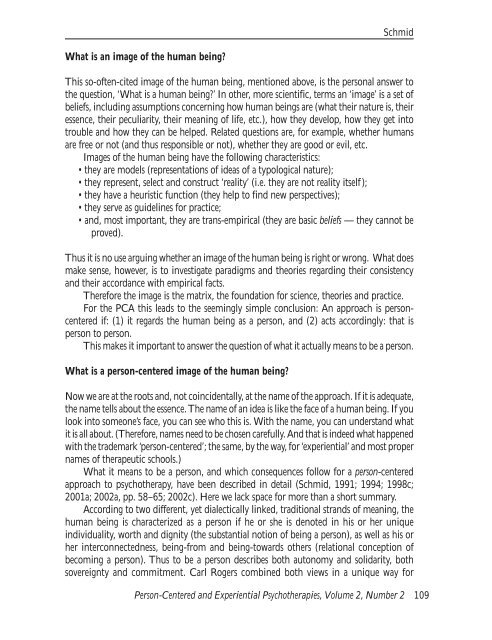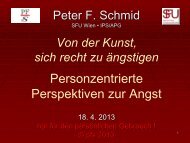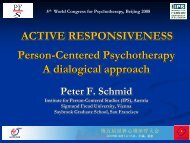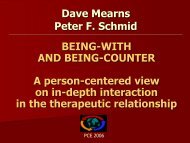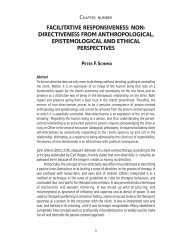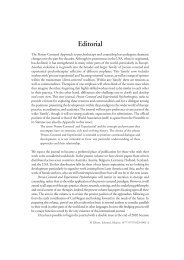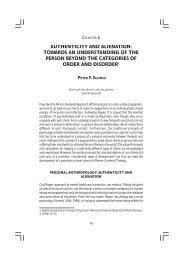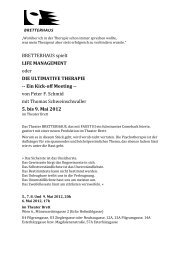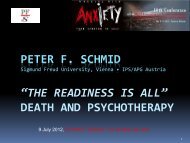The Characteristics of a Person-Centered ... - Peter F. Schmid
The Characteristics of a Person-Centered ... - Peter F. Schmid
The Characteristics of a Person-Centered ... - Peter F. Schmid
- No tags were found...
You also want an ePaper? Increase the reach of your titles
YUMPU automatically turns print PDFs into web optimized ePapers that Google loves.
<strong>Schmid</strong>What is an image <strong>of</strong> the human being?This so-<strong>of</strong>ten-cited image <strong>of</strong> the human being, mentioned above, is the personal answer tothe question, ‘What is a human being?’ In other, more scientific, terms an ‘image’ is a set <strong>of</strong>beliefs, including assumptions concerning how human beings are (what their nature is, theiressence, their peculiarity, their meaning <strong>of</strong> life, etc.), how they develop, how they get intotrouble and how they can be helped. Related questions are, for example, whether humansare free or not (and thus responsible or not), whether they are good or evil, etc.Images <strong>of</strong> the human being have the following characteristics:• they are models (representations <strong>of</strong> ideas <strong>of</strong> a typological nature);• they represent, select and construct ‘reality’ (i.e. they are not reality itself);• they have a heuristic function (they help to find new perspectives);• they serve as guidelines for practice;• and, most important, they are trans-empirical (they are basic beliefs — they cannot beproved).Thus it is no use arguing whether an image <strong>of</strong> the human being is right or wrong. What doesmake sense, however, is to investigate paradigms and theories regarding their consistencyand their accordance with empirical facts.<strong>The</strong>refore the image is the matrix, the foundation for science, theories and practice.For the PCA this leads to the seemingly simple conclusion: An approach is personcenteredif: (1) it regards the human being as a person, and (2) acts accordingly: that isperson to person.This makes it important to answer the question <strong>of</strong> what it actually means to be a person.What is a person-centered image <strong>of</strong> the human being?Now we are at the roots and, not coincidentally, at the name <strong>of</strong> the approach. If it is adequate,the name tells about the essence. <strong>The</strong> name <strong>of</strong> an idea is like the face <strong>of</strong> a human being. If youlook into someone’s face, you can see who this is. With the name, you can understand whatit is all about. (<strong>The</strong>refore, names need to be chosen carefully. And that is indeed what happenedwith the trademark ‘person-centered’; the same, by the way, for ‘experiential’ and most propernames <strong>of</strong> therapeutic schools.)What it means to be a person, and which consequences follow for a person-centeredapproach to psychotherapy, have been described in detail (<strong>Schmid</strong>, 1991; 1994; 1998c;2001a; 2002a, pp. 58–65; 2002c). Here we lack space for more than a short summary.According to two different, yet dialectically linked, traditional strands <strong>of</strong> meaning, thehuman being is characterized as a person if he or she is denoted in his or her uniqueindividuality, worth and dignity (the substantial notion <strong>of</strong> being a person), as well as his orher interconnectedness, being-from and being-towards others (relational conception <strong>of</strong>becoming a person). Thus to be a person describes both autonomy and solidarity, bothsovereignty and commitment. Carl Rogers combined both views in a unique way for<strong>Person</strong>-<strong>Centered</strong> and Experiential Psychotherapies, Volume 2, Number 2 109


